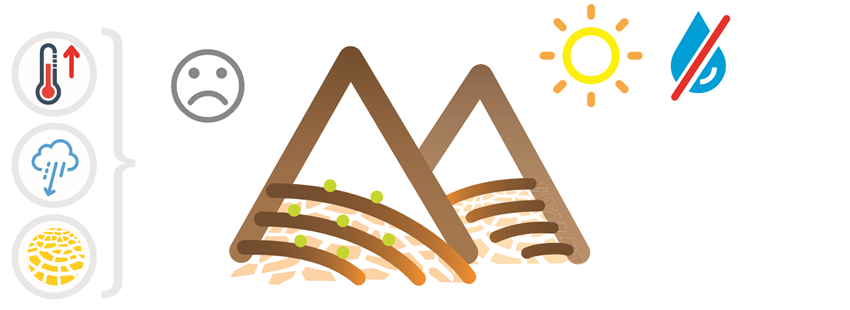Agriculture and livestock are key socio-economic sectors owing to their high strategic, economic and territorial value on both sides of the Pyrenees. Mountain pastures are fundamental to this sector and generate several ecosystem services for society, including provisioning services, maintenance of biodiversity, landscape resources, quality water resources and carbon storage. The increase in the concentration of atmospheric CO2, the consequent increase in air temperature, as well as changes in seasonal precipitation patterns and the greater frequency and intensity of extreme climate events will affect agriculture, pastures and the livestock sector in the Pyrenees, generating changes of varying magnitude and type varying in each area.
Possible increase in productivity of mountain pastures
Mountain pastures are an important resource in the agricultural sector. Not only that, these agrosystems have a high level of biodiversity and landscape and cultural value. Productivity in pastures in the Pyrenees is somewhat limited by low temperatures and scarcity of water. The increase in average temperatures, together with the fertilising effect of the greater concentration of atmospheric CO2, will likely increase the productivity of mountain pastures, barring severe droughts in spring and summer. On the other hand, it could also lead to changes in pasture properties and quality, with potential negative effects for the sector.
Climate extremes such as heat waves and droughts are also causing physical and chemical changes in plants, which often cause damage to plant tissue and a resulting loss of pasture quality. All of this could result in a reduction in the quality and quantity of fodder, which may in turn alter the performance and end quality of livestock and their by-products (e.g. meat, dairy, etc.).
Climate change is an added stress factor which can act in synergy with land use changes, current trends in agroecosystem degradation and the gradual abandonment of extensive alpine farming.
Changes in climate suitable distribution areas for some crops

Changes in climate conditions will likely cause displacement of potentially suitable areas for the proper cultivation of some crops. Whilst the potential distribution area of some crops such as maize may contract, others such as grapes and olives may benefit.
Reduced agricultural productivity because of greater climate variability and extreme climate events

The productivity of crops and pastures is highly dependent on two factors: temperature, and the amount of water available in the soil. Climate change has a direct influence over both these variables and may negatively affect the amount and quality of agricultural production. In addition to the gradual changes caused by the slow increase in temperatures and more variable precipitation, extreme climate events (heat waves, droughts and intense precipitation) may cause occasional yet highly significant impacts on pyrenean crops. The observed and predicted impacts includes agrophenological changes (changes in the calendar of the annual cycle of the main crops) and changes in the productivity and quality of crops due to the alteration of the vegetative cycle and to the greater frequency and intensity of extreme climatic events.
the wheat flowering date was brought forward by an average of 0.35 ± 0.15 days per year between 1985 and 2014, with significant differences between areas. Similarly, the maturation or grain filling process — and therefore the harvest date — have been brought forward considerably during the last thirty years, which constitutes a considerable acceleration in the crop growing season. This generally leads to poorer crop performance, since it involves a less efficient use of thermal energy, the sun's radiation and the available water resources. In the winemaking sector, earlier flowering and harvesting could result in a significant drop in productivity in some areas. The grape flowering and harvesting dates on both sides of the Pre-Pyrenees could come forward by 30 ± 10 days and 40 ± 10 respectively in 2040-70 with respect to 1980-2005. One negative effect observed during recent decades is caused by early ripening coinciding with the greater frequency of extreme climate events, such as summer heat waves and intense rainfall. Grapes under these conditions absorb and lose a large quantity of water over a short period and can end up damaged as a result. This continuous process of hydration and drying caused by an intermittent excess of heat and water often results in the skin of the fruit breaking and the ripe grape rotting before it is harvested. Grapevine productivity could increase under moderate temperature increases, although the quality of the harvest and the properties of the final product could also be altered (greater alcohol content in the wine).
Increased thermal stress and risk of spread of disease amongst livestock

Livestock production will also be directly and indirectly affected by climate change. Changes in temperature and humidity have a direct influence on animal health and performance, and high temperatures and climatic extremes can indirectly affect animal production owing to fewer and poorer-quality grazing areas. Furthermore, the new climate conditions could encourage greater spread and prevalence of livestock diseases, including those transmitted by vectors.
Recommendations
Productivity of agricultural systems is critically dependent on a range of factors, including climate conditions. The overall effects of climate change on agricultural productivity can be summarised as the outcome of the interactions between the increased concentration of atmospheric CO2, the variation in the length of the growing season, change in water availability and the spread or proliferation of plagues and diseases. Short term adaptation strategies based on relatively simple agricultural practices — such as changing sowing dates or crop varieties — may not be sufficient in the long term.
Among the main challenges that the Pyrenean agropastoralism must and should face in the coming decades, from the OPCC we highlight:
- Reducing uncertainty around the greatest risks, possible negative effects and future pressures on farming and grazing ecosystems in the Pyrenees.
- Increasing the resilience of mountain farming and grazing systems to the pressures of climate change.
- Strengthening pro-conservation land management to increase its natural fertility and maximise its function as a carbon sink.
- Encouraging management techniques in the sector which ensure sustainable water use and integrated management of this resource.
- Developing systems for monitoring emerging pathogenic organisms and diseases in livestock and crops.
- Limiting abandonment in the sector and incentivising diversification and modernisation based on overall climate change challenges.
PYRENEAN CLIMATE CHANGE OBSERVATORY
Avenida Nuestra Señora de la Victoria, 8
22.700 - Jaca
Huesca - España
+34 974 36 31 00
info_opcc@ctp.org




